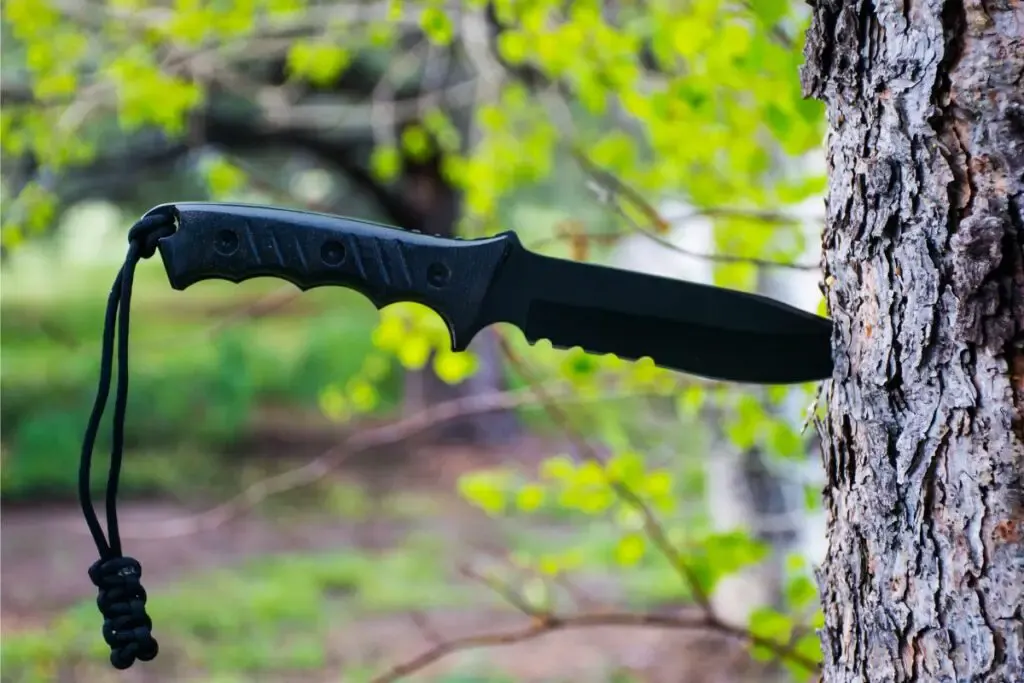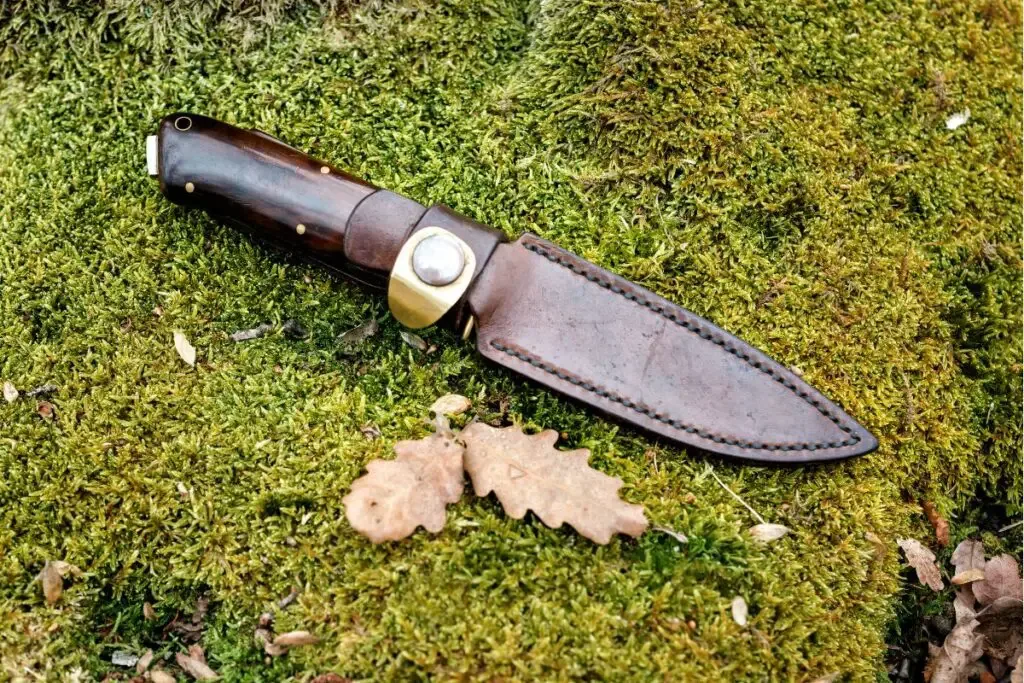As an Amazon Associate, we earn from qualifying purchases with no additional costs for you.
Many people debate the merits of a serrated survival knife compared with a plain-edge knife. The serrated knife was the brainchild of an inventor, Joseph E Burns, of Syracuse, USA, who was awarded a patent for this invention in 1922. The serrations are really sharpened peaks and valleys on the knife’s edge that make a sawing-cutting action possible, greatly improving the blade’s ability to cut difficult materials. It was originally designed with bakers in mind for the cutting of soft bread.
There is no question that both the serrated and the straight-edged knife have a place in a survival pack. Ideally, if you have one of each, then you will cover all bases. That would be my ideal choice, and I would go perhaps a little bit bigger rather than a little bit too small in blade size.
There are many factors that can sensibly be argued both ways that will influence one’s choice in this matter. There is no definitive answer. Choosing between a serrated or plain-edged survival knife involves many trade-offs. In the end, anticipated circumstances, practicality, and personal choice are the deciding factors.
However, the topic here is, which is better? For this, we are going to assume that you have to make a choice, one or the other. So, here are some of the important factors that you should consider.
If you are interested in checking out one of the best survival knives, we recommend taking a look at a TOPS brand bushcraft or Fieldcraft knife. You can find it by clicking here (Amazon link).
Should A Survival Knife Be Serrated?

Serrated knife blades tend to tear rather than make the clean cut that a straight-edged knife will make. The saw effect of the serrated blade generally outperforms the straight-edge blade’s cutting effect on difficult-to-cut materials.
They are particularly effective for cutting through thick rope, safety belts, safety harnesses, and branches and saplings.
When sharp, serrated blades come out tops you have to do something like that in a hurry. A further positive attribute of the serrated knife is that it generally tends to remain sharper for longer than a plain edge blade and will cut even when a little bit dull.
In a chopping action, the serrations present a smaller edge face that will be in contact with the object, thus projecting greater forces onto a smaller amount of metal, thereby increasing the damage potential to the serration peaks.
A chopping action with a straight-edged blade presents much more of the cutting edge to the object, will absorb impact with less damage, and therefore will chop better for longer.
An important downside with a serrated knife is that they are a lot more complex to re-sharpen than a straight cutting edge.
Sharpening them entails the re-cutting of the individual bevels in between the peaks. This restores the peaks, which can then be re-sharpened, but this requires a fair amount of skill and equipment.
To do it by hand would require a lot of time, skill, and a sharpening stone of the correct radius and pitch to match the existing bevels. Unless one is a skilled knife sharpener, this task is best carried out by a professional knife sharpener. But you are unlikely to find one of those in the wild.
Any knife will eventually become blunt after some time in use. The advantage of the plain-edged knife is that it can be honed back to sharp. If the blade has reached the point where honing does not bring it back to a keen edge, then it can be easily re-sharpened on a whetstone.
Therefore, having a whetstone as part of your EDC for a survival event would make sense. This is not a lesson on knife sharpening techniques, but it is worthwhile reading about the difference between honing and sharpening an edge and correctly using a simple whetstone.
Honing is polishing the edge, such as using a leather strop or steel, whilst sharpening means removing metal, thereby re-cutting the edge angle that has been worn down.
TIP: A sharp knife is not only more useful than a dull knife, but it is also safer to use. Read about the top 10 reasons why a sharp knife is safer than a dull one in our article below!
10 Reasons Why A Sharp Knife Is Safer Than A Dull One (Tested)
Why Do Survival Knives Have Serrated Edges?

When the points of the serrations are wickedly sharp, nothing cuts better than a serrated-edged knife. A negative is that when (not “if”) the serrated edge becomes dull, then it is very difficult to re-sharpen, and you are unlikely to be carrying the tools necessary to do that job.
Let’s face it, though, if the knife starts out sharp; it is only going to be dulled after some lengthy service in a survival situation. Generally, a survival situation is likely to be minutes, hours, or days rather than weeks or months. So, is re-sharpening really a major issue in your envisaged situation?
TIP: A bread knife is a type of serrated-edged kitchen knife, and there are certain items you should not cut with this knife. Find out more in our article on the topic!
What To Cut & NOT To Cut With A Bread (Serrated) Knife
Is a Serrated Knife Better for Survival?
A huge Rambo-style fighting/survival knife with those seriously wicked teeth on it looks diabolically impressive, even terrifying. Especially if someone comes at you angrily waving it around. Hopefully, it will have the same effect if you need to frighten off an attacker.
But is it practical in an everyday survival kit (EDS)? Popular thought has it that a serrated knife edge will stay sharper for longer than a plain edge. It will also cut through certain materials more easily than a straight-edge knife.
Serrated-edge knife blades function as a saw whereby the separated teeth mean less contact area with the material being cut. The bevels in between the teeth allow a bit of clearance, reducing friction. It is friction that causes a straight-edged blade to drag when slicing.
The sawing action using a serrated knife makes it easier to cut through bone, wood, and such. In a remote survival situation, being able to cut down branches or saplings would allow you to build some sort of shelter.
A major factor influencing the choice between serrated or straight-edge survival knives is that the plain-edged blade can be sharpened with minimal tools.
At an absolute push, you could scrape it on a rock and get a modest edge. This is not so with a serrated edge which requires some sophisticated attention for re-sharpening.
PRO TIP: We personally use diamond plates by Atoma. They are quite expensive but of the top quality with very long service life.
The initial costs are higher but you have an option of buying replacing diamond skin for all Atoma plates. The costs of replacing diamond skin are much lower than the cost of buying a new diamond plate.
So if you are going to use diamond plates regularly and want to get the best quality on the market, check out the four Atoma diamond plates listed below (Amazon links).
- Atoma Diamond Sharpener Coarse Grade 140 Grit
- Atoma Diamond Sharpener Medium 400 Grit
- Atoma Diamond Sharpener Fine 600 Grit
- Atoma Diamond Sharpener Super Fine 1200 Grit
These 4 diamond sharpening stones are all you need to have for repairing or sharpening your knives.
Serrated Vs. Plain-Edge Survival Knife

The argument for or against one or the other is fraught with trade-offs. There are numerous positives and negatives in either choice. So here we are going to be playing devil’s advocate and list some items for consideration.
- The serrations on a large survival knife give it a menacing appearance way beyond that of a plain edge. It just looks like “the business.”
- The plain-edge knife may not have the same intimidating look, but if you waved it at me, I would still be paying attention.
- Serrated knife blades are much more difficult to re-sharpen than plain-edge. But be honest, what are the chances of you being in a survival situation for lengthy periods whereby your knife will become dull? You will only have to cut safety belts so many times in this lifetime.
- A super sharp plain edge will do everything required. It will also make short work of a safety belt. You can also use it to cut your nice tender steak and not frighten the guests at your barbecue.
- Serrated blades can be damaged relatively easily if, for example, you are chopping branches or small trees. The teeth are not designed with impact in mind.
- Straight-edged knives are quite suited for chopping branches or saplings. Of course, one needs a larger blade with a bit of weight in it. It is pointless trying to do the job with a pocket knife.
- A dull straight edge can be brought back to sharp quickly and easily, many times over, with nothing more than a diamond or whetstone.
- The nature of the serrations on a blade is that the individual peaks tend to tear rather than cut cleanly, but greater pressure on the smaller cutting area gives the edge a better cutting ability.
- A straight edge will give a much cleaner, more precise cut. Of course, if it is sharp.
- Plain-edged knives have been around for thousands of years and did the job.
- Serrated knives have only been around for a hundred years and are a serious contender. There must be something there.
Conclusion
What has not been mentioned so far is quality. The evaluations above are all based on a decent-quality knife.
Blades made from the appropriate steel correctly hardened and tempered, and with a sound fitting of the bolster and handle materials. You do not want the thing to fall apart on the first chop or the edge to buckle at the first sign of hard work.
Both types of blades are worthy contenders for survival knives. My choice, as a knife maker, hunter, and outdoorsman (also ex-military), would be a straight-edge blade.
It would have a seven to eight-inch blade made from ¼ inch material. Definitely, it would be full tang with a substantial bolster incorporating a finger guard to stop the knife sliding back up the hand when stabbing bears and things.
The best advice of all, plan to stay out of survival situations by thinking ahead. If you are in it, adopt the military doctrine, improvise, adapt, adjust, and overcome.
TIP: You need special sharpeners to correctly sharpen a survival knife with a serrated edge. Read all about the top sharpeners for serrated knives in our article on the topic!
TOP 7 Knife Sharpeners For Serrated Knives: Complete Guide
